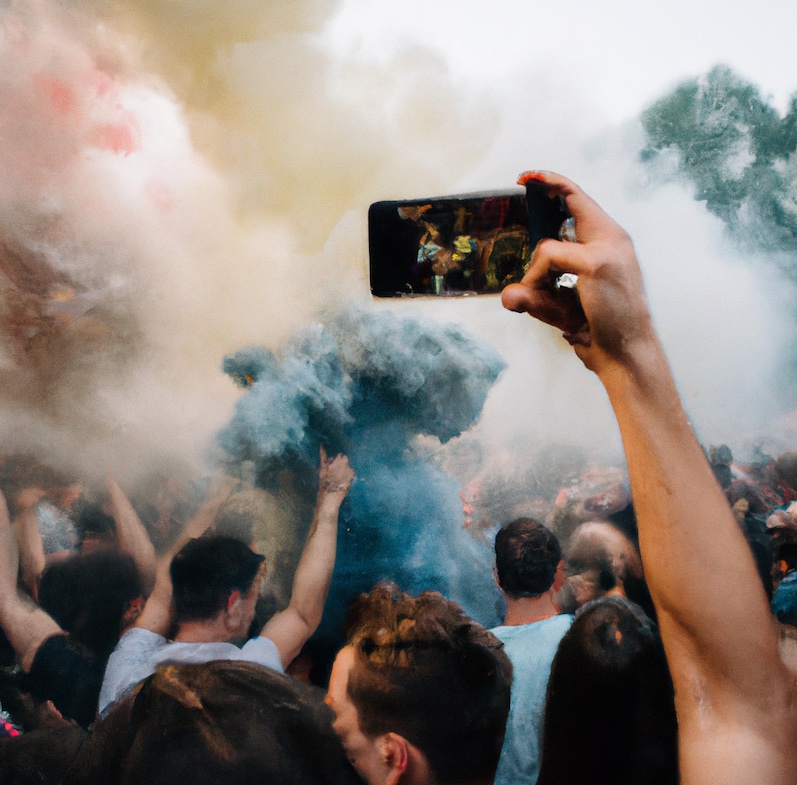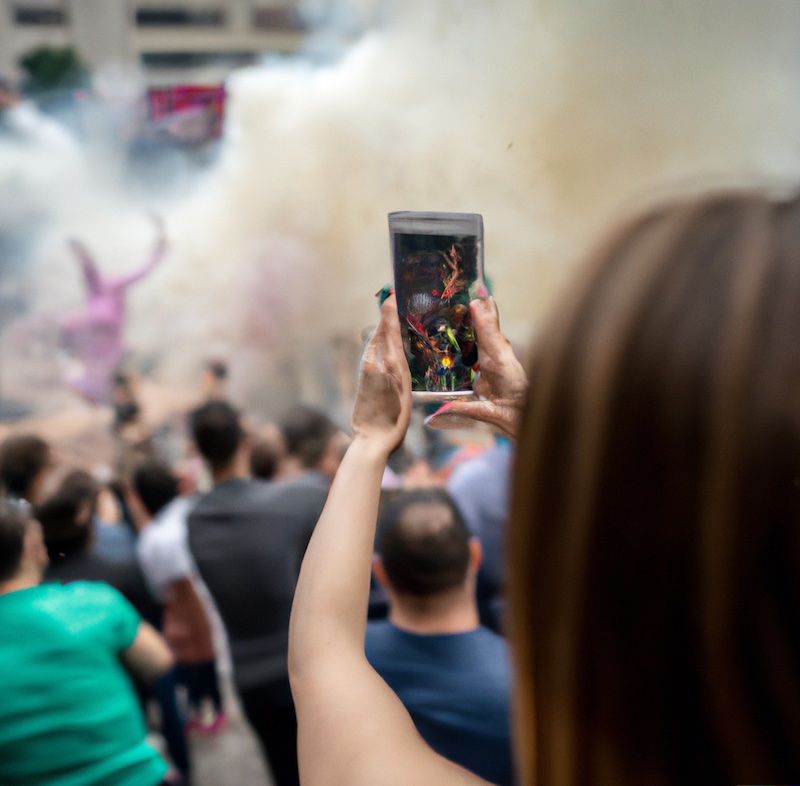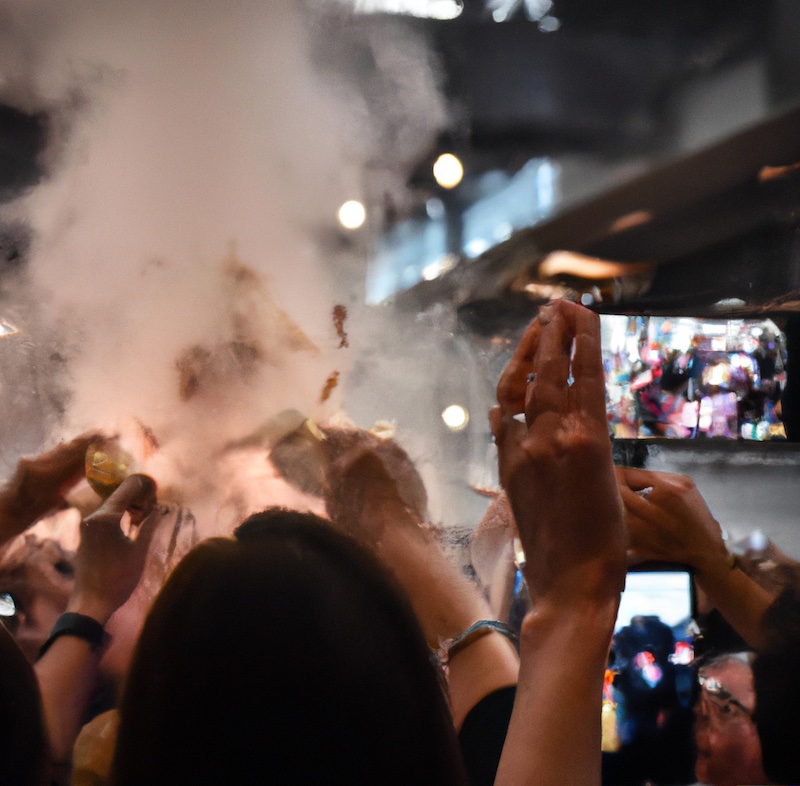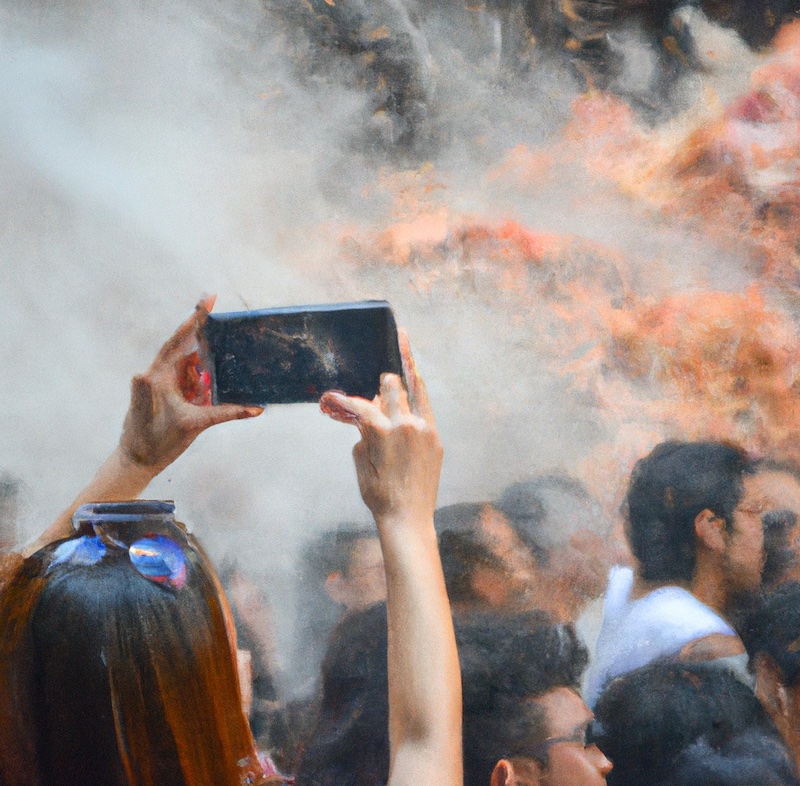Causalité dans The happening

The happening est une série de photographies réalistes que j’ai réalisée avec l’IA DALL-E 2, à laquelle j’ai eu accès en juillet 2022. Beaucoup de questions surgissent avec son emploi, que je compte poser régulièrement à l’aide de ces petits articles que je rédige.
Ici ce qui m’interroge, c’est la relation entre le photo-réalisme et la question de la causalité. Dans notre réel, toute image que nous captons, donc toute photographie, est liée à une chaine de causalité. Lorsque je vois par exemple une rue de Paris, de San Paolo ou de L.A avec des passants, chaque être, chaque objet est impliqué dans la photographie selon un schème temporel et causal. Avec les réseaux sociaux, et la multiplication des micro-vidéos type tik-tok, nous sommes submergés par des images qui reposent sur des micro-actions. Même un paysage, lorsqu’il est photographié est lié à une causalité : celle qui dot que celui qui photographie est en voyage, en vacances, en week-end, etc…
 The happening est une série de photographies réalistes d’un événement. Mais quelle est la causalité dans l’image. Nous voyons une foule photographier quelque chose, mais nous ne savons pas quoi. Il y a une causalité qui est celle du prompt (le texte qui est donné à DALL-E 2), prompt que je tords toujours pour que le résultat déborde l’attendu descriptif, mais il n’y a pas de causalité interne à l’image. En travaillant sur une imprévisibilité du rendu, je brise la possibilité référentielle et réelle dans le rendu. Ceci peut se faire en interrogeant les limites des possibles de rendu de DALL-E 2. Si Etienne Mineur par exemple, a très bien vu en quel sens certaines catégories sont hyper stéréotypées et faciles à représenter pour DALL-E 2, il est possible de faire l’inverse questionner les limites du rendu d’objets, d’associations. Ce qui demande de questionner tout à la fois la logique d’assemblage grammatical du moteur, la nature des banques d’images ayant servi pour le dataset et enfin les restrictions introduites moralement par l’équipe de open-ai.
The happening est une série de photographies réalistes d’un événement. Mais quelle est la causalité dans l’image. Nous voyons une foule photographier quelque chose, mais nous ne savons pas quoi. Il y a une causalité qui est celle du prompt (le texte qui est donné à DALL-E 2), prompt que je tords toujours pour que le résultat déborde l’attendu descriptif, mais il n’y a pas de causalité interne à l’image. En travaillant sur une imprévisibilité du rendu, je brise la possibilité référentielle et réelle dans le rendu. Ceci peut se faire en interrogeant les limites des possibles de rendu de DALL-E 2. Si Etienne Mineur par exemple, a très bien vu en quel sens certaines catégories sont hyper stéréotypées et faciles à représenter pour DALL-E 2, il est possible de faire l’inverse questionner les limites du rendu d’objets, d’associations. Ce qui demande de questionner tout à la fois la logique d’assemblage grammatical du moteur, la nature des banques d’images ayant servi pour le dataset et enfin les restrictions introduites moralement par l’équipe de open-ai.
L’événement dont nous avons une trace n’a ni passé ni futur, car l’image n’a pas de causalité historique, ou encore toute causalité narrative de l’image est extérieure à sa fabrication. The happening met le spectateur de l’image face à une temporalité en suspension du point de vue de la causalité temporelle. L’IA ne construisant aucunement
Ce point est une différence majeure avec la photographie ou bien encore avec l’illustration, au sens où justement la production de l’image étant déléguée à un processus technique, celui-ci n’implique pas la construction du sens de l’image. Ou encore la mémoire sémiotique liée à la liaison image/texte n’est pas de l’ordre de la causalité narrative et historique, mais de la relation esthétique par contiguité, pour reprendre une distinction de Hume très utile.
Dès lors l’image produite par une IA est du point de vue de celle-ci, celle d’un présent pur de la contiguité des éléments, le temps de l’image ne se déploie pas dans le temps de l’action, mais seulement dans le temps de la relation. C’est le spectateur humain qui, selon la causalité temporelle, et la mémoire événementielle ou narrative, va s’interroger sur un chainage de l’événement.
_______________________________________
[ENGLISH]
The happening is a series of realistic photographs that I made with the DALL-E 2 AI, to which I had access in July 2022. Many questions arise with its use, which I intend to ask regularly using of these little articles that I write.
Here what questions me is the relationship between photo-realism and the question of causality. In our reality, any image we capture, therefore any photograph, is linked to a chain of causality. When I see, for example, a street in Paris, San Paolo or L.A with passers-by, each being, each object is involved in the photograph according to a temporal and causal scheme. With social networks, and the proliferation of tik-tok type micro-videos, we are overwhelmed by images that are deposited on micro-actions. Even a landscape, when it is photographed, is linked to a causality: the one that points out that the photographer is on a trip, on vacation, on a weekend, etc…
 The happening is a series of realistic photographs of an event. But what is the causality in the picture. We see a crowd photographing something, but we don’t know what. There is a causality which is that of the prompt (the text which is given to DALL-E 2), a prompt which I always twist so that the result overflows the descriptive expectation, but there is no internal causality to the prompt. ‘image. By working on an unpredictability of rendering, I break down the referential and real possibility in rendering. This can be done by questioning the limits of the possible rendering of DALL-E 2. If Etienne Mineur for example, has seen very well in what sense certain categories are hyper stereotyped and easy to represent for DALL-E 2, it is possible to doing the opposite questioning the limits of the rendering of objects, of associations. This requires questioning both the grammatical assembly logic of the engine, the nature of the image banks used for the dataset and finally the restrictions morally introduced by the open-ai team.
The happening is a series of realistic photographs of an event. But what is the causality in the picture. We see a crowd photographing something, but we don’t know what. There is a causality which is that of the prompt (the text which is given to DALL-E 2), a prompt which I always twist so that the result overflows the descriptive expectation, but there is no internal causality to the prompt. ‘image. By working on an unpredictability of rendering, I break down the referential and real possibility in rendering. This can be done by questioning the limits of the possible rendering of DALL-E 2. If Etienne Mineur for example, has seen very well in what sense certain categories are hyper stereotyped and easy to represent for DALL-E 2, it is possible to doing the opposite questioning the limits of the rendering of objects, of associations. This requires questioning both the grammatical assembly logic of the engine, the nature of the image banks used for the dataset and finally the restrictions morally introduced by the open-ai team.
The event of which we have a trace has neither past nor future, because the image has no historical causality, or any narrative causality of the image is external to its fabrication. The happening puts the spectator of the image in front of a temporality in suspension from the point of view of temporal causality. AI not building at all
This point is a major difference with photography or even with illustration, in the sense that precisely the production of the image being delegated to a technical process, this one does not imply the construction of the meaning of the image. Or again, the semiotic memory linked to the image/text link is not of the order of narrative and historical causality, but of the aesthetic relationship by contiguity, to take up a very useful distinction from Hume.
Therefore the image produced by an AI is from its point of view, that of a pure present of the contiguity of the elements, the time of the image does not unfold in the time of the action, but only in the time of the relationship. It is the human spectator who, according to temporal causality, and event or narrative memory, will wonder about a chaining of the event.


